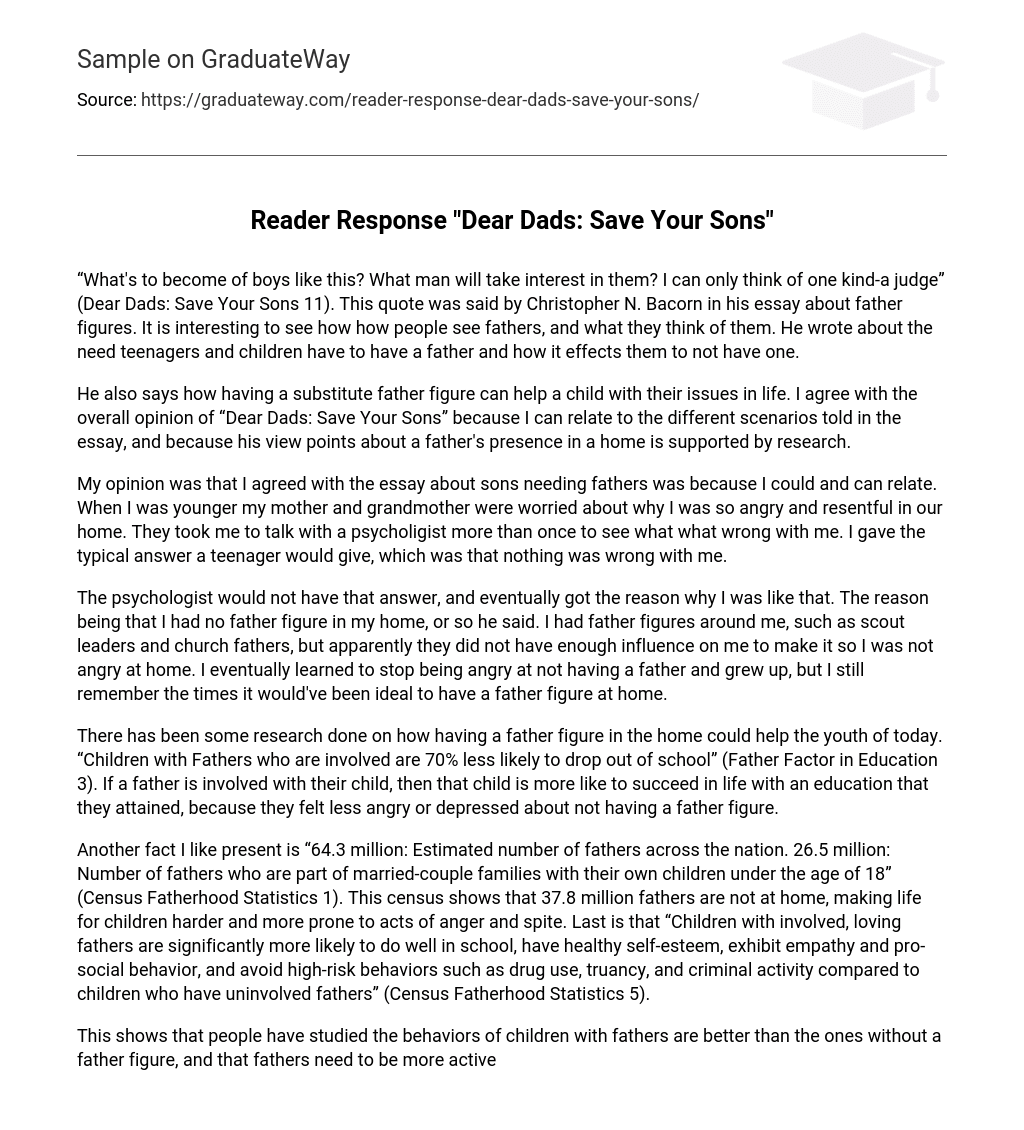“What’s to become of boys like this? What man will take interest in them? I can only think of one kind-a judge” (Dear Dads: Save Your Sons 11). This quote was said by Christopher N. Bacorn in his essay about father figures. It is interesting to see how how people see fathers, and what they think of them. He wrote about the need teenagers and children have to have a father and how it effects them to not have one.
He also says how having a substitute father figure can help a child with their issues in life. I agree with the overall opinion of “Dear Dads: Save Your Sons” because I can relate to the different scenarios told in the essay, and because his view points about a father’s presence in a home is supported by research.
My opinion was that I agreed with the essay about sons needing fathers was because I could and can relate. When I was younger my mother and grandmother were worried about why I was so angry and resentful in our home. They took me to talk with a psycholigist more than once to see what what wrong with me. I gave the typical answer a teenager would give, which was that nothing was wrong with me.
The psychologist would not have that answer, and eventually got the reason why I was like that. The reason being that I had no father figure in my home, or so he said. I had father figures around me, such as scout leaders and church fathers, but apparently they did not have enough influence on me to make it so I was not angry at home. I eventually learned to stop being angry at not having a father and grew up, but I still remember the times it would’ve been ideal to have a father figure at home.
There has been some research done on how having a father figure in the home could help the youth of today. “Children with Fathers who are involved are 70% less likely to drop out of school” (Father Factor in Education 3). If a father is involved with their child, then that child is more like to succeed in life with an education that they attained, because they felt less angry or depressed about not having a father figure.
Another fact I like present is “64.3 million: Estimated number of fathers across the nation. 26.5 million: Number of fathers who are part of married-couple families with their own children under the age of 18” (Census Fatherhood Statistics 1). This census shows that 37.8 million fathers are not at home, making life for children harder and more prone to acts of anger and spite. Last is that “Children with involved, loving fathers are significantly more likely to do well in school, have healthy self-esteem, exhibit empathy and pro-social behavior, and avoid high-risk behaviors such as drug use, truancy, and criminal activity compared to children who have uninvolved fathers” (Census Fatherhood Statistics 5).
This shows that people have studied the behaviors of children with fathers are better than the ones without a father figure, and that fathers need to be more active in a child’s life.The fact fathers could be in a child’s life is one choice they make themselves, and have all the consequences follow said action. Everything that happens depends on a father’s choice since they are the core of the family unit. Everything that has happened to me or any other kid is based on what happens at home. From having a better education to getting incarcerated all depends on whether a child has a figure he or she can look up to, depend on, and learn from. Not having a father can effect anybody, anywhere, at anytime with what they do with their life.
Works Cited
Bacorn, Christopher. “Dear Dads: Save Your Sons”. Evergreen. Susan Fawcett. Boston: Wadsworth
2014. 599. print
“The Fatherless Generation.” thefatherlessgeneration.wordpress.com/statistics/. Web. 10/11/13





